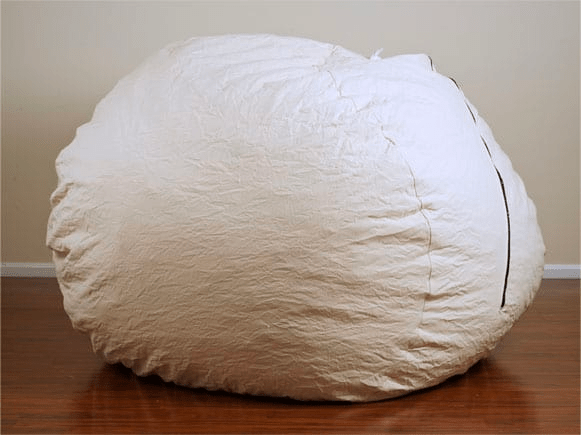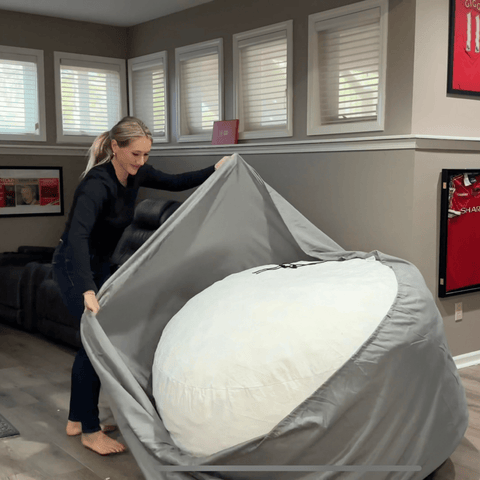Free Shipping on orders over $200

Types of Filling for Bean Bag Chairs
So what are bean bag chairs filled with? The answer is that various types of filling materials are available, each with unique advantages.
In this comprehensive guide, we will explore the different types of bean bag chair fillings, their benefits and their drawbacks to help you determine the perfect fit for your needs and preferences.
What Are Bean Bag Chairs Filled With?
Bean bag chairs can be filled with a wide variety of filler materials. The following are some of the most commonly used fillers for bean bags.
Expanded Polystyrene (EPS)
EPS is a lightweight, rigid, closed-cell foam material that is commonly used in bean bag chairs. EPS bean bag filler is made by expanding polystyrene beads. Due to its affordability, it’s a popular choice of bean bag filler.
Pros of EPS Beads
- Lightweight: EPS beads are quite light, making bean bags easy to move and handle, even for children.
- Affordable: EPS is an economical filling choice for bean bags, making it an attractive option for budget-conscious consumers.
- Durable: EPS beads are known for retaining their shape for an extended period.
Cons of EPS Beads
- Flammability: EPS beads can be flammable if exposed to an open flame, so it's essential to keep your bean bag chair away from any sources of fire. Fortunately, most EPS products on the market have been chemically treated to reduce the risk. When purchasing EPS bean bag filler or an EPS-filled bean bag chair, check the label to make sure that it has been treated with flame-retardant chemicals.
- Environmental Concerns: EPS is technically recyclable. Specialized facilities can melt and reprocess EPS bean bag fill into new products like packaging materials. Unfortunately, there are limited EPS recycling facilities in the U.S., and not all accept EPS in the form of bean bag filler. Additionally, most curbside recycling programs do not take EPS because transporting it is difficult and costly.
Expanded Polypropylene (EPP)
EPP is a versatile plastic foam material known for its excellent energy absorption and impact resistance. It is commonly used for automotive and packaging products.
EPP is also used as a bean bag filler. EPS beads share many characteristics with EPS, but they are more resilient and offer better resistance to compression.
Pros of EPP Beads
- Resilient and durable: EPP beads maintain their shape better than EPS beads, providing long-lasting comfort. EPP beads do not break easily because they are designed to withstand higher pressure and impacts. This means your bean bag will retain its shape and support for a longer period, minimizing the need for frequent refills.
- Comfortable: EPP beads are more flexible than EPS filler and can conform to your body shape for a softer, plusher feel.
- Lightweight: EPP beads weigh less than EPS beads, making it easy to move your bean bag.
- Quiet: EPP beads are quieter when shifting around, minimizing that annoying crinkly sound often associated with EPS.
- Recyclable: At the end of its usable life, you might be able to recycle EPP bean bag chair filler. Many recycling facilities and curbside programs now accept EPP materials.
Cons of EPP Beads
- Cost: EPP is slightly more expensive than EPS, which may deter some customers.
- Availability: EPP bean bag filler is less widely available than EPS, so you may need to search harder for it.
Microbeads
Microbeads are tiny, round plastic pellets, typically made from EPS or EPP. They are commonly used in travel pillows and some bean bag chairs due to their smooth and fluid feel, creating a molding effect.
Pros of Microbeads
- Comfort: Microbeads offer a luxurious, silky feel and conform to the shape of your body.
- Lightweight: Microbead filling is light, making it easy to lift and move your bean bag chair as needed.
- Quiet: Because of their tiny size, microbeads don’t make much noise, which helps create a more peaceful atmosphere when you’re sitting and watching a movie or relaxing.
Cons of Microbeads
- Durability: Due to their small size, microbeads can break down over time, causing the bean bag chair to lose its shape and support.
- Environmental concerns: In the past, microbeads in personal care products were widely banned because they contribute to microplastic pollution. For the same reason, many places in the United States have banned the use of microbeads not just in cosmetics and skincare but in all products, including bean bag fill.
Shredded Memory Foam (Polyurethane)
Memory foam or viscoelastic polyurethane foam is a type of polyurethane foam to which substances are added to give it unique properties, such as next-level softness, support and durability. It is a popular cushioning material for pillows, mattresses, cars, and, of course, bean bag chair filling.
Shredded memory foam filler is composed of small, irregularly shaped pieces of memory foam. The shredded memory foam can mold and contour to the user's shape, providing customized comfort.
Pros of Shredded Polyurethane or Memory Foam
- Supportive and Comfortable: Unlike traditional polystyrene beans that may lose shape and provide inadequate support over time, shredded memory foam fill provides consistent and long-lasting support and comfort.
- Breathable: Shredded memory foam fillers contain tiny air pockets that allow air to circulate, preventing heat and moisture buildup. This feature contributes to a more comfortable and cool seating experience.
- Durable: Bean bags filled with shredded memory foam maintain their shape and structure better than those filled with polystyrene beans, requiring less frequent refills.
- Hypoallergenic: For individuals with allergies or sensitivities, shredded memory foam is a suitable option as it is hypoallergenic and resistant to mold, mildew and dust mites.
- Eco-Friendly Options Available: Many manufacturers produce eco-friendly shredded memory foam fillers from recycled or repurposed materials. These sustainable options help to minimize waste and reduce the environmental impact of manufacturing new foam products.
Cons of Shredded Polyurethane or Memory Foam
- Weight: Memory foam is denser and heavier than other filler materials, such as polystyrene beads, which can make bean bags filled with it harder to move or adjust.
-
Cost: Shredded memory foam tends to be more expensive than other fillers, which can make the upfront price of bean bag chairs filled with it costlier compared to other options. However, this higher price tag comes with the added benefits of durability, longevity, and comfort.
How Much Does Bean Bag Filler Cost?
The cost of bean bag chair filling depends on various factors, including:
- Manufacturer or brand
- Location of the purchase
- Type of filler material
- Density and quality of the filler
- Quantity
To give you a better idea of the cost, here are the four most common types of bean bag chair filled discussed in the previous sections, listed from cheapest to most expensive.
- EPS beads
- EPP beads
- Microbeads
- Shredded Memory Foam
Note that if you’re purchasing bean bag chair fill online, you must also account for shipping fees.
How Much Filler Is Needed for a Bean Bag?
Bean bag chairs come in a wide range of sizes, from small kid-sized chairs to massive seats that accommodate two or more people. The amount of filler required depends primarily on the size of the bean bag chair and the type of filler being used.
At Ultimate Sack, we offer memory foam bean bag filler in two weights: 16 lbs. if your bean bag needs a light topping up and 25 lbs. for a complete replacement of existing filler.
How to Add Beans to a Bean Bag
Refilling or topping up a bean bag is a simple process. Just follow these steps:
- Lay the bean bag cover flat, then open the zipper or Velcro closure.
- Carefully pour the filling material into the cover to avoid spillage. A funnel or scoop can help with this process.
- Close the zipper or Velcro, then shake and adjust the bean bag chair to distribute the filling evenly.
- Test the chair's comfort; if necessary, add or remove filler until the desired level of firmness is achieved.
Get more detailed instructions on how to fill a bean bag chair here.
Shop Online for High-Quality Bean Bag Chair Filling
Bean bag chairs offer a trendy, comfortable seating option for any home, but it's essential to consider the filling material used to ensure a comfortable and durable product. With options like expanded polystyrene (EPS), expanded polypropylene (EPP), microbeads, and shredded memory foam, customers can find the best filler for bean bags that meet their comfort preferences and budget.
At Ultimate Sack, all our bean bag chairs come prefilled with shredded polyurethane foam for your convenience. You won't have to look elsewhere if you need to add more fill to your chairs. We also offer shredded polyurethane foam in bags of 16 lbs. and 25 lbs., as well as replacement canvas liners.
View our selection, and place your order today!
